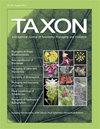基于 nrITS 和质体 DNA 序列的 Prosthechea(兰科 Laeliinae)系统发育:重新评估 "跳跃者-分裂者 "之争,揭示这一新热带属的进化过程
IF 2
2区 生物学
Q2 EVOLUTIONARY BIOLOGY
引用次数: 0
摘要
在经历了一段混乱的分类历史之后,Prosthechea(兰科Laeliinae)已被广义地界定为包括以前归入Encyclia亚种Osmophytum的物种。然而,最近出现了新的分类方法,恢复了旧名,如 Anacheilium 和 Hormidium,并提出了新属,如 Euchile、Panarica、Pollardia 和 Pseudencyclia,将 Prosthechea 分成更窄的属。在本研究中,我们提供了 Prosthechea 的分子系统发育,以重新评估其他属的分类,并阐明这一高度多样化的新热带族系的进化方面。我们对 80 个 Prosthechea s.l. 物种和 12 个相关属的物种进行了采样。对三个质体区(rpl32-trnL、trnD-trnT 和 ycf1)和 nrITS 的序列进行了贝叶斯分析和最大解析分析。核数据与质粒数据之间可能存在的冲突通过分区布雷默支持(partitioned Bremer support)进行了评估。提供了与属分类相关的形态特征的始祖状态重建。我们的研究结果加强了与 Prosthechea 的广义划分相对应的单系。与 Euchile、Panarica 和 Hormidium 相对应的小支系是单系的,而较大的 Anacheilium、Pollardia 和 Pseudencyclia 不是单系的。我们的系统发育并不支持将 Prosthechea 分成更小的属,而非单系也阻碍了全面的属下分类的提出。与之前提出的形态亲缘关系相比,我们发现的系统发生关系更好地反映了生物地理学模式,这表明该属内部存在同形花特征。发现了核分区与质体分区之间的冲突,这表明可能存在网状进化的情况。本文章由计算机程序翻译,如有差异,请以英文原文为准。
Phylogeny of Prosthechea (Laeliinae, Orchidaceae) based on nrITS and plastid DNA sequences: Reassessing the lumper-splitter debate and shedding light on the evolution of this Neotropical genus
After a confused taxonomic history, Prosthechea (Laeliinae, Orchidaceae) has been circumscribed in a broad sense to include species previously placed in Encyclia subg. Osmophytum. However, recent alternative classifications resurrecting old names such as Anacheilium and Hormidium, and proposing new genera such as Euchile, Panarica, Pollardia, and Pseudencyclia were presented, splitting Prosthechea into narrower genera. In this study, we provide a molecular phylogeny of Prosthechea to reassess alternative generic classifications and shed light on evolutionary aspects of this highly diverse Neotropical lineage. Eighty species of Prosthechea s.l. and 12 species of related genera were sampled. Bayesian and maximum parsimony analyses of sequences from three plastid regions (rpl32-trnL, trnD-trnT, ycf1) and nrITS were included. Possible conflicts between nuclear and plastid data were assessed with partitioned Bremer support. Ancestral state reconstructions of morphological characters relevant to the genus taxonomy are provided. Our results reinforce the monophyly of the lineage corresponding to a broad circumscription of Prosthechea. The small lineages corresponding to Euchile, Panarica, and Hormidium are monophyletic, whereas the larger Anacheilium, Pollardia, and Pseudencyclia are not monophyletic. Splitting Prosthechea into smaller genera is not supported by our phylogeny, and nonmonophyly also hinders the proposal of a comprehensive infrageneric classification. The phylogenetic relationships recovered reflect better the biogeographic patterns than the previously proposed morphological affinities, pointing to the existence of homoplastic floral traits within the genus. Conflicts between nuclear and plastid partitions were detected, suggesting a possible scenario of reticulate evolution.
求助全文
通过发布文献求助,成功后即可免费获取论文全文。
去求助
来源期刊

Taxon
生物-进化生物学
CiteScore
4.70
自引率
8.80%
发文量
177
审稿时长
6-12 weeks
期刊介绍:
TAXON is the bi-monthly journal of the International Association for Plant Taxonomy and is devoted to systematic and evolutionary biology with emphasis on plants and fungi. It is published bimonthly by the International Bureau for Plant Taxonomy and Nomenclature, c/o Institute of Botany, Slovak Academy of Sciences, Dúbravská cesta 9, SK-845 23 Bratislava, SLOVAKIA. Details of page charges are given in the Guidelines for authors. Papers will be reviewed by at least two specialists.
 求助内容:
求助内容: 应助结果提醒方式:
应助结果提醒方式:


